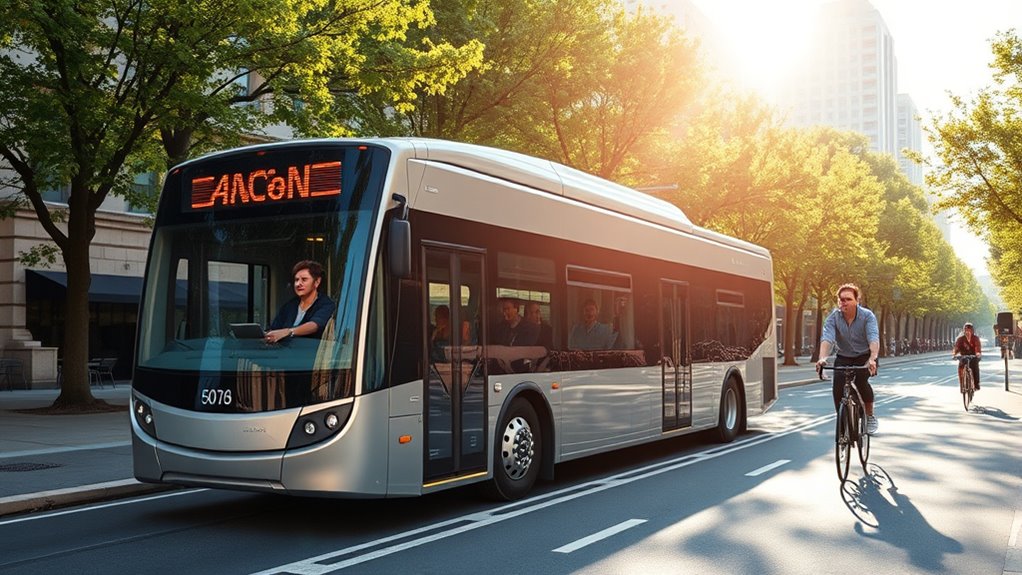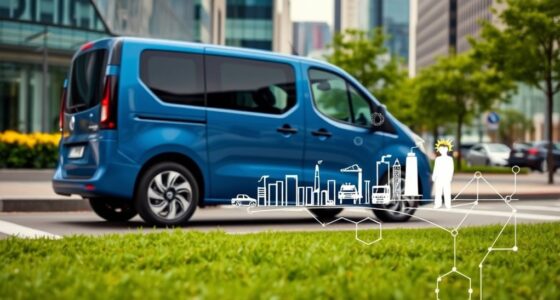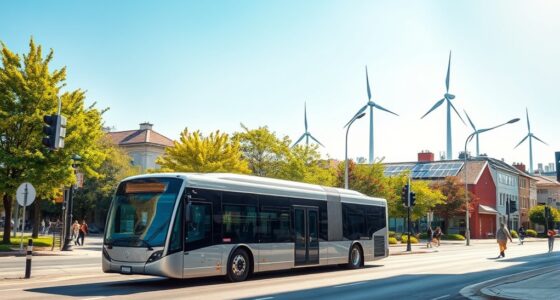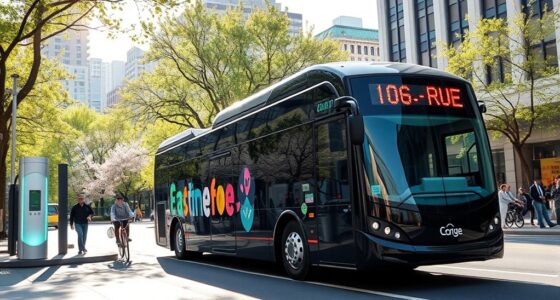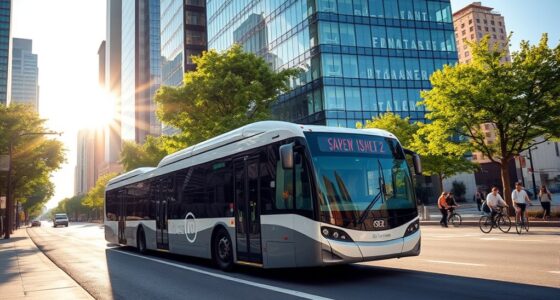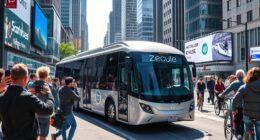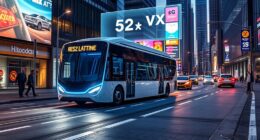Electric buses play a crucial role in improving public health by reducing air pollution and lowering emissions of harmful pollutants like nitrogen oxides and particulate matter. This means cleaner air, fewer respiratory problems, and healthier communities—especially for vulnerable groups like children and low-income populations. They also save money, create jobs, and cut noise pollution. Keep exploring how policies, innovations, and infrastructure developments are making cleaner transportation a reality for everyone.
Key Takeaways
- Electric buses emit fewer greenhouse gases and particulate matter, leading to cleaner air and reduced respiratory issues.
- Switching to electric buses decreases children’s exposure to harmful pollutants, improving their respiratory health.
- Reduced noise pollution from electric buses enhances community well-being and lowers stress levels.
- Adoption of electric buses supports public health cost savings by lowering healthcare expenses related to pollution-related diseases.
- Infrastructure and policy initiatives promote cleaner transportation, further improving urban air quality and public health outcomes.
How Electric Buses Reduce Air Pollution and Enhance Community Health

Electric buses play a crucial role in reducing air pollution and improving community health. They emit far fewer greenhouse gases than diesel buses, helping to create cleaner air.
By cutting particulate matter emissions, electric buses lessen pollution that causes respiratory and cardiovascular issues. The impact varies by region, depending on how clean the electricity is, but overall, they markedly lower emissions during operation thanks to more efficient motors.
Electric buses significantly reduce emissions that cause respiratory and heart problems, especially when powered by clean energy sources.
Replacing diesel buses with electric ones can save over 2 million tons of greenhouse gases annually. This shift eliminates harmful diesel exhaust, reduces ground-level ozone, and improves air quality, especially in urban areas where pollution is worse.
Better air quality means healthier communities, fewer pollution-related health problems, and a step toward a more sustainable, cleaner environment.
The Impact of Electric Buses on Childhood Asthma and Vulnerable Populations
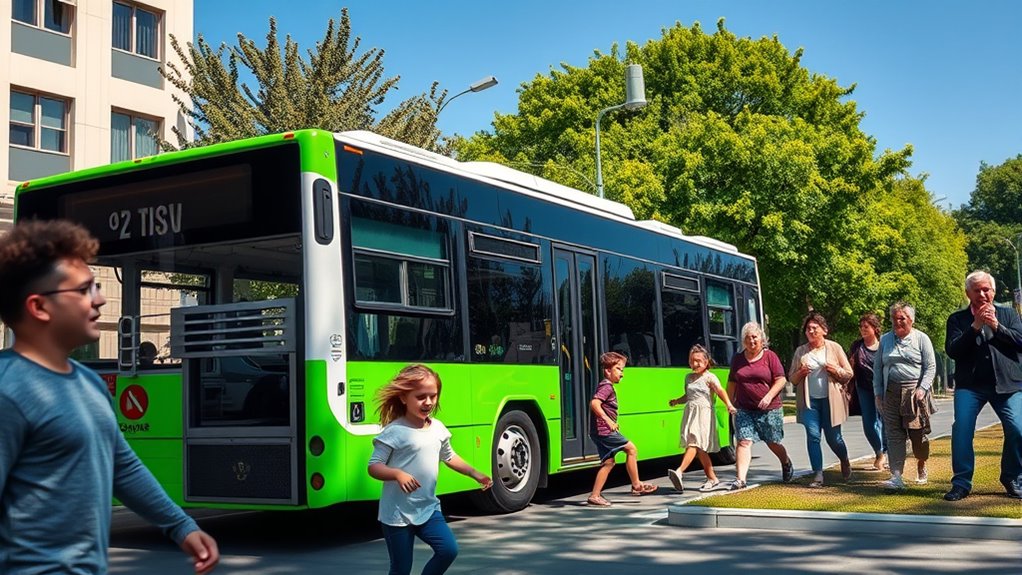
How considerably do electric buses impact the health of vulnerable populations, especially children with asthma? Transitioning to electric buses markedly reduces exposure to harmful diesel pollutants like nitrogen oxides and particulate matter, which are linked to asthma flare-ups.
Since 95% of U.S. school buses run on diesel, children—particularly those with preexisting conditions—face heightened risks of respiratory issues, hospitalizations, and absenteeism. Children breathe in higher pollutant levels inside poorly ventilated diesel buses, worsening health outcomes. Indoor air quality can be significantly improved by switching to electric vehicles, further protecting children’s health. Additionally, the adoption of holistic care models can support comprehensive health improvements in these communities.
Electric buses emit no tailpipe pollutants, decreasing asthma attacks and associated health disparities in low-income and marginalized communities. By improving air quality during daily commutes, electric buses help protect vulnerable populations from chronic respiratory problems and reduce long-term health risks.
Implementing high-quality filtration systems in electric buses can further enhance air quality inside vehicles, providing additional health benefits for children and at-risk groups. Incorporating advanced filtration can also address indoor air quality issues, ensuring cleaner environments. This transition fosters healthier, safer environments for children and at-risk groups.
Economic Advantages of Electric Buses for Public Health and Local Communities
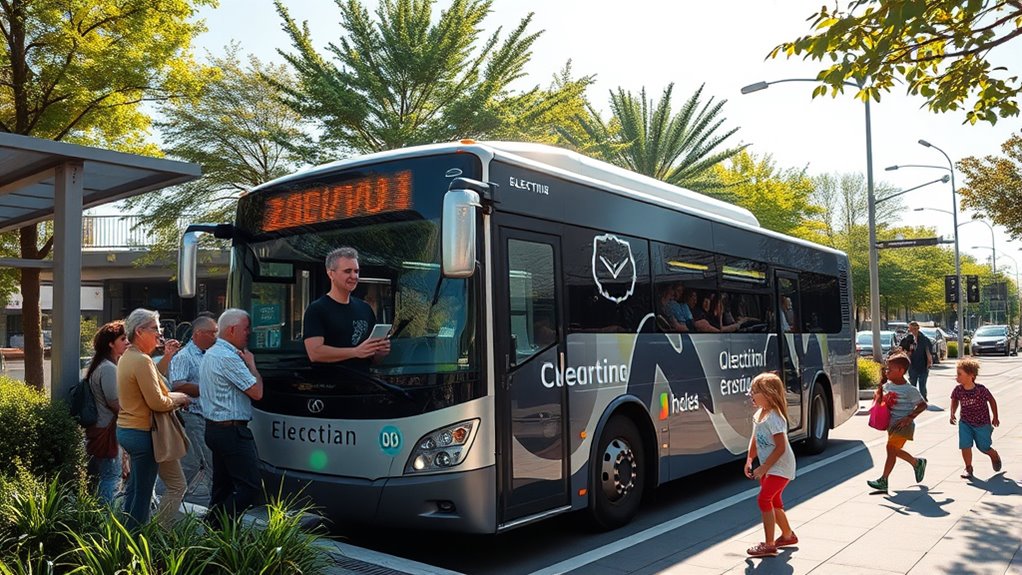
Switching to electric buses offers significant economic advantages that positively impact public health and local communities. You’ll save money, as electric buses cost about 2.5 times less to fuel than diesel buses, and they consume less energy annually. This leads to lower operating costs and helps stretch transportation budgets further.
Replacing a diesel bus with an electric one provides health benefits valued at over $200,000 per bus, mainly through improved air quality and reduced pollution. Additionally, electric buses generate less noise, enhancing community well-being.
The shift fosters local economic growth by creating jobs in manufacturing and infrastructure development. With government incentives and stable energy prices, investing in electric buses becomes financially attractive, supporting a cleaner, healthier environment while boosting local economies.
Technological Innovations Supporting Cleaner Transportation

Technological innovations are transforming transportation toward greater environmental sustainability and safety. Electric buses cut greenhouse gases, improving urban air quality and public health. Autonomous vehicle technology boosts safety and efficiency, reducing accidents and emissions. Hydrogen fuel cells provide zero-emission alternatives, further decreasing pollution.
Magnetic levitation trains use less energy and offer fast, efficient travel, though they’re less common in cities. Solar power is also explored as a renewable energy source for transportation. Traffic management systems like ATMS optimize traffic flow, cut congestion, and lower emissions. Smart traffic systems utilize real-time data to dynamically adjust signals and routes, further enhancing efficiency. Implementing renewable energy sources in transportation infrastructure can further reduce reliance on fossil fuels and promote sustainability.
Real-time data and AI-driven route optimization reduce travel distances and fuel use. Fleet maintenance predictions ensure vehicles run efficiently, decreasing breakdowns and pollution. Additionally, breakfast delivery options tailored to health-conscious consumers can promote better nutrition and public well-being. By integrating personality insights, transportation programs can better cater to diverse community needs, fostering greater adoption of these cleaner options. These innovations collectively support cleaner, healthier transportation options for communities.
Policy Strategies and Infrastructure Development for Healthier Cities
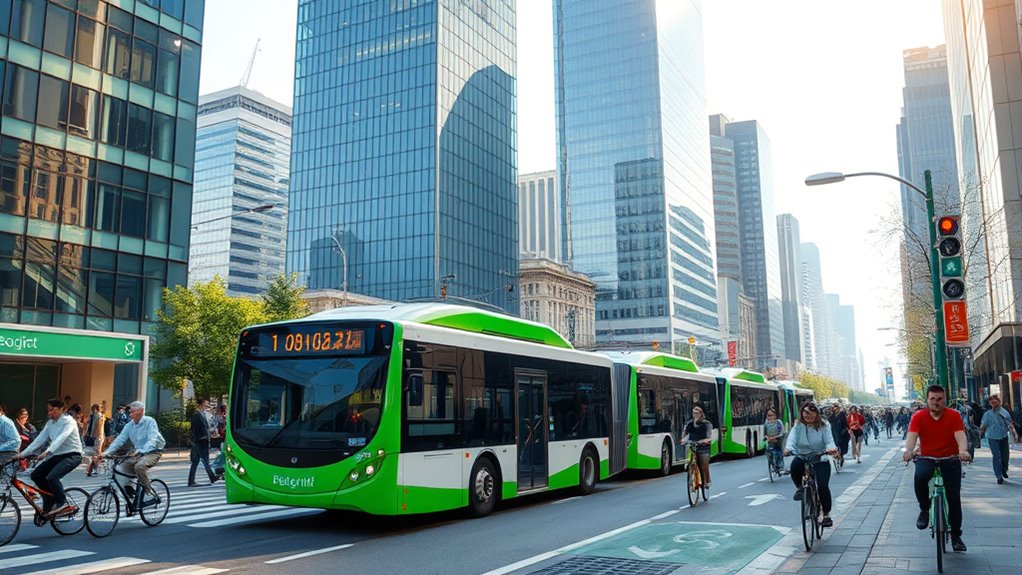
Effective policy strategies and infrastructure development are essential for creating healthier urban environments through cleaner transportation. You are trained on data up to October 2023. Incorporating innovative Volkswagen Tuning techniques can also contribute to reducing emissions by optimizing engine performance and fuel efficiency in fleet vehicles. Public-private partnerships and carbon credit markets help fund fleet electrification and infrastructure upgrades. Prioritizing the retirement of pre-2005 diesel buses and optimizing routes reduces PM2.5 exposure for vulnerable populations. Upgrading grid capacity, developing smart charging hubs, and establishing interoperability standards ensure reliable, sustainable infrastructure. Community engagement, transparent reporting, and regulatory mandates further accelerate shift, transforming urban spaces into healthier, cleaner environments for all residents. Additionally, market research can assist policymakers in identifying the most effective interventions tailored to specific city needs. Recognizing the importance of cookie management and data transparency can foster public trust and support for these initiatives. Implementing data privacy measures aligned with cookie policies further enhances community confidence in transportation and environmental programs.
Frequently Asked Questions
How Do Electric Buses Impact Indoor Air Quality in Transit Stations?
You might wonder how electric buses impact indoor air quality in transit stations. They produce zero tailpipe emissions, so they don’t introduce pollutants into the station environment. This reduces outdoor pollutants that can enter the station and affect air quality.
Additionally, electric buses tend to be quieter and generate less indoor pollution, which helps maintain healthier air inside stations. Regularly monitoring air quality guarantees a safe, comfortable environment for passengers and staff alike.
What Are the Long-Term Health Benefits of Replacing Diesel With Electric Buses?
You’ll see long-term health benefits when you replace diesel buses with electric ones. They cut air pollution by eliminating tailpipe emissions, which reduces respiratory and cardiovascular illnesses.
This shift also lowers greenhouse gases, helping fight climate-related health risks. Plus, quieter electric buses decrease noise pollution, improving mental well-being.
Over time, you’ll save money on healthcare and maintenance costs, making your community healthier, cleaner, and more sustainable.
How Do Electric Buses Influence Healthcare Costs for Communities?
You can see that electric buses cut healthcare costs by reducing respiratory illnesses and air pollution exposure. They lower emergency visits, chronic disease management, and asthma treatment expenses.
Plus, they save money on fuel and maintenance, freeing funds for health programs.
In urban areas, the health benefits are especially significant, helping communities breathe easier, lower stress, and improve overall well-being, making public health efforts more sustainable and equitable.
Are Electric Buses Safer for Passengers and Drivers Than Traditional Buses?
You might wonder if electric buses are safer for passengers and drivers. They generally reduce fire risks due to lower flammability and eliminate diesel exhaust, improving air quality.
Quieter operation and regenerative braking enhance safety and comfort. However, you should be aware of thermal runaway risks in batteries and guarantee proper driver training.
What Role Do Electric Buses Play in Reducing Noise Pollution in Cities?
Electric buses play a crucial role in reducing city noise pollution by operating much more quietly than diesel-powered buses. You’ll notice less engine and exhaust noise, creating a calmer urban environment.
This quieter operation benefits residents and pedestrians, making neighborhoods more peaceful and livable. Plus, lower noise levels help reduce stress and improve mental health, encouraging more people to use public transportation and supporting sustainable urban growth.
Conclusion
While electric buses promise cleaner air and healthier communities, it’s ironic how such technological marvels often face delays and resistance. Instead of swiftly transforming cities into healthier spaces, we sometimes cling to outdated fuels, ignoring the obvious benefits. You might think progress would be seamless, but the real challenge is overcoming inertia. In the end, it’s amusing how we chase after a greener future while hesitating to make the simple switch that could save lives today.
